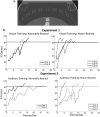Noise-rearing precludes the behavioral benefits of multisensory integration
- PMID: 35332919
- PMCID: PMC9930622
- DOI: 10.1093/cercor/bhac113
Noise-rearing precludes the behavioral benefits of multisensory integration
Abstract
Concordant visual-auditory stimuli enhance the responses of individual superior colliculus (SC) neurons. This neuronal capacity for "multisensory integration" is not innate: it is acquired only after substantial cross-modal (e.g. auditory-visual) experience. Masking transient auditory cues by raising animals in omnidirectional sound ("noise-rearing") precludes their ability to obtain this experience and the ability of the SC to construct a normal multisensory (auditory-visual) transform. SC responses to combinations of concordant visual-auditory stimuli are depressed, rather than enhanced. The present experiments examined the behavioral consequence of this rearing condition in a simple detection/localization task. In the first experiment, the auditory component of the concordant cross-modal pair was novel, and only the visual stimulus was a target. In the second experiment, both component stimuli were targets. Noise-reared animals failed to show multisensory performance benefits in either experiment. These results reveal a close parallel between behavior and single neuron physiology in the multisensory deficits that are induced when noise disrupts early visual-auditory experience.
Keywords: cross-modal; development; multisensory integration; noise-rearing; vision.
© The Author(s) 2022. Published by Oxford University Press. All rights reserved. For permissions, please e-mail: journals.permissions@oup.com.
Figures




References
-
- Alais D, Burr D. The ventriloquist effect results from near-optimal bimodal integration. Curr Biol. 2004:14:257–262. - PubMed
-
- Barraclough NE, Xiao D, Baker CI, Oram MW, Perrett DI. Integration of visual and auditory information by superior temporal sulcus neurons responsive to the sight of actions. J Cogn Neurosci. 2005:17:377–391. - PubMed
-
- Battaglia PW, Jacobs RA, Aslin RN. Bayesian integration of visual and auditory signals for spatial localization. J Opt Soc Am. 2003:20:1391–1397. - PubMed
Publication types
MeSH terms
Grants and funding
LinkOut - more resources
Full Text Sources
Medical

